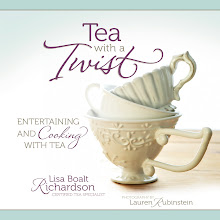Oh, the food in Japan is something to be desired! Before I move on to the factory, I thought you might be interested in our lunch that was served at the tea auction facility. As a big foodie, I couldn't skip our lunch presentation for you. This is the Japanese version of a boxed lunch!
Inside the box was some riced topped with various kinds of delicious sushi and sashimi along with a small bottle of soy sauce and wasabi. It was so yummy and the perfect lunch to gear us up for the next part of the day!
 After lunch we headed out to the hojicha factory. (Reminder of what hojicha is.) As the bus pulled up and we all climbed out, you could smell this lovely roasting aroma permeating the air. Once again were asked to put on hairnets and take off our shoes and put on slippers for sanitary purposes. Although the look isn't the most attractive, I appreciate the effort for cleanliness.
After lunch we headed out to the hojicha factory. (Reminder of what hojicha is.) As the bus pulled up and we all climbed out, you could smell this lovely roasting aroma permeating the air. Once again were asked to put on hairnets and take off our shoes and put on slippers for sanitary purposes. Although the look isn't the most attractive, I appreciate the effort for cleanliness.  As we toured to facility, the smell was intoxicating. We watched how the tea is taken through to finalize it. Since most everything is done by machines, there were only two workers inside this plant working. You can again see the high sanitary level of the workers. The workers had to wear gloves as well. The mask is not just for sanitary purposes, but also so she doesn't breath in all the hojicha dust.
As we toured to facility, the smell was intoxicating. We watched how the tea is taken through to finalize it. Since most everything is done by machines, there were only two workers inside this plant working. You can again see the high sanitary level of the workers. The workers had to wear gloves as well. The mask is not just for sanitary purposes, but also so she doesn't breath in all the hojicha dust. Below you can see how the back wall of this bin is covered in tea and beside it are large bags of tea ready to go to market.
 After our tour of the plant, we headed off to a wholesale company selling teapots and teacups. Our day wrapped up with dinner on our own again. The first night out, we discovered this Thai restaurant called Colonial Kitchen so a group of us decided to venture out to try it. We were very fortunate to find an English speaking waiter. He was excited to practice his English too so it worked out well for everyone!
After our tour of the plant, we headed off to a wholesale company selling teapots and teacups. Our day wrapped up with dinner on our own again. The first night out, we discovered this Thai restaurant called Colonial Kitchen so a group of us decided to venture out to try it. We were very fortunate to find an English speaking waiter. He was excited to practice his English too so it worked out well for everyone! Can you tell we are tea people? With all the tea on the table, we had a hard time finding room for our plates. I loved the way they served tea in this restaurant, don't you?
In this picture is: Far back from left to right, Elise Scott of Pearl Fine Teas, Ken Rudee of Barnes and Watson Fine Teas, and Judith Krall-Russo of Tea Food History . In the front row is Newman Johnston of Teas Etc. and Lynayn Mielke of East-West Tea Emporium.
Here's a toast to you as you follow me on my journey to day three where we will discover a lovely historic Japanese teahouse, temple, and the big O-Cha (Tea) Festival!
Happy Sipping, Lisa




























